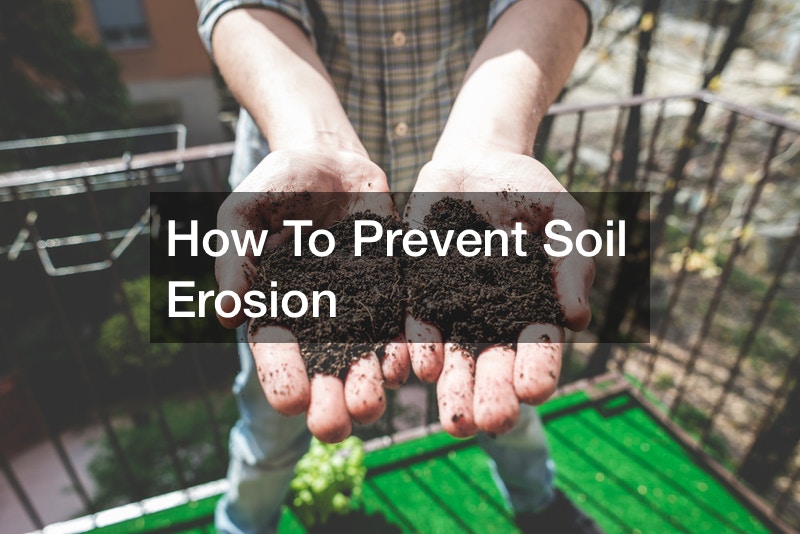How To Prevent Soil Erosion


There are a lot of ways to reduce soil erosion, although many of them mainly work on a broader scale. Today, plenty of different global processes are contributing to soil erosion. The causes of soil depletion are complicated, and fixing the issue globally will probably require a lot of different changes.
The consequences of erosion are undeniable. People will have to worry about a lot of great farming soil being lost along the way. This overall loss of great soil can also threaten ecosystems. The seawall erosion repair process can be just as complex.
There are 4 major types of erosion, but many of them will have similar effects and similar causes, which means that it might be possible to at least address all four of these different soil erosion types at once.
Something as simple as planting one tree can help to stop soil erosion. The roots of the tree are great at holding the soil in place. People can also find that the trees tend to be the focal points of entire ecosystems. The planting of trees on a broader level can help to stop even more soil erosion. However, people can certainly start with one tree at a time.
Soil erosion can pose serious issues to a foundation. The erosion of a foundation causes significant problems, such as instability and other hazardous elements to seep in further damaging the foundation—a building’s foundation is its core and erosion threatens it. Although erosion seems to be inevitable, there are certain ways to take control of soil erosion to prevent costly damages to your foundation. Soil erosion is a primary concern for construction. There is a constant increase in its severity during larger, more extensive projects which cause manufacturers to develop products to take control of soil erosion. The cause of erosion is caused by cumulative factors that have gradually grown over time, depending on the factor and its severity solutions vary.
1.Articulated concrete blocks are a readily available resource for the control of soil erosion. They vary by thickness and shape, depending on the level of concrete structuring needed to stabilize the foundation. They’re also used as a type of revetment system for stabilizing an embankment or preventing erosion from water runoff.
2. Mechanically Stabilized Earth or MSE walls have replaced traditional concrete walls. Although concrete is the most commonly used human-made material, MSE walls are the best alternative because of its wide range of advantages like installation time, control of soil erosion and adaptability of earth retention. They are quite versatile for construction and can withstand near any concrete projects.
3. Turbidity Barriers are another good alternative that man civil construction companies use for their projects. These barriers are structured for retaining walls, preventing soil erosion, controlling water flow, and promoting earth retention.
4. French drains are made up of underground piping systems that are used as a channel lining that enables it for controlling water flow to an exit. The pipes are also perforated to allow water seeping into the soil underneath the title. French drains can guarantee control of water erosion.
5. Soil nails consist of drilling into the soil to place steel bars within the ground. This method offers resistance against slope failures, preventing erosion from water runoff. Installation for soil nails is straightforward as well which makes it a popular choice. The steel bars are equipped with capped surfaces to create a barrier that resembles retaining walls.
6. Riprap is another commonly used material for erosion control in areas where dense water runoff is prominent, such as a lakeshore or riverbed.
Canal lining is an impermeable layer between the bed and the side of the canal to improve the lifespan and discharge capacity of the canal. Implementing canal lining allows there to be more protection for the foundation of the canal and meet safety standards to ensure its effects won’t be detrimental on the environment. There are two major types of lining used based on the surface:
Earthen type lining: Compacted Earth Lining and Soil Cement Lining, compacted earth lining is used for canals if the Earth’s surface is readily available near the construction site. Using compaction dramatically reduces soil pore sizes by displacing air and water which increases density, compressive strength, the strength of soil, and reduces permeability present in the soil. The soil-cement lining is constructed with mixtures of sandy soil, cement, and water, which eventually hardens into a concrete-based material.This material is placed through dry-mix method or plastic mix method.
Hard surface lining: Hard surface lining is comprised into four subdivided categories, cement concrete lining, brick lining, plastic lining, and boulder lining. Cement concrete lining is a popular type of lining because of its tough, durable, and hydraulically efficient which allows it to be suitable for both small and large channels of high and low flow velocities.
Brick:Brick lining is considered one of the more simplistic types of canal linings. Bricks are laid using cement mortar on the sides and bed of the canal, after which a smooth finish is apparent on the canal’s surface.
Plastic lining: Still a recently developed technique, the plastic lining is optimal for easy handling, spreading and transport, immune to chemical action, and a speedier construction.
Boulder lining:Made of stone, boulder lining sounds exactly as it is. The lining is constructed with stones laid in mortar, which makes it considerably limited in its uses.

